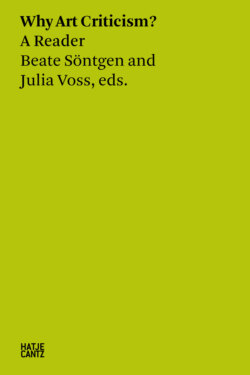Читать книгу Why Art Criticism? A Reader - Группа авторов - Страница 11
ОглавлениеClemens Brentano, Achim von Arnim
On October 13, 1810, the newspaper Berliner Abendblätter published a review which later aroused lasting interest, particularly in more recent art historical and literary studies. The subject of the short text was Caspar David Friedrich’s painting Monk by the Sea, which at the time was being shown at the annual exhibition of the Berlin Academy. While Kleist’s review is quite famous, the first draft of this text, written by Clemens Brentano and Achim von Arnim, has remained to this day in the shadow of the more pointed, finally published version.Their text exemplarily stands for an art criticism that does not focus on explaining the characteristics, qualities, and shortcomings of a work of art; neither does it concentrate on describing the viewer’s experience in front of the painting as precisely as possible. Rather, the two authors have chosen the strategy of finding verbal and literary equivalents for essential moments of this aesthetic experience—and these equivalents gain their profile and quality precisely through being conscious of the fundamental difference between linguistic text and vivid picture.
In a few words, “that which I should have found within the picture I found instead between the picture and myself, namely a claim that my heart made on the picture, and a rejection that the picture did to me by not fulfilling it,” Brentano and Arnim plainly state that Caspar David Friedrich’s painting was not conceived to aim at illusion or even immersion, but unambiguously revealed itself as a picture—a flat, confined, painted, man-made artifact. It is only in this context that Kleist’s monstrous metaphor, which was added later—“the viewer feels as though his eyelids had been cut off”—wins its explosive force. In the combination of Brentano’s, Arnim’s, and Kleist’s observations, a fundamentally new concept of the power of pictures emerges. The picture no longer wins power over its viewers through deceptively similar depiction, production of effects of presence, or seductive fidelity to reality, but rather gains this effect as an artifact that ostentatiously reveals its status as a painting, instead of veiling it in favor of the depicted subject’s appearance. While Kleist’s text only affirms this fundamental insight, Brentano’s and Arnim’s dialogues attempt to make this partial loss of control accessible and tangible to readers. Using linguistic and literary devices, they recreate and regenerate what the observer can experience in the sensory perception of the picture itself, with three important verbal and literary strategies: 1) phonetic and semantic shifts, 2) figures of supplementation, and 3) moments of shifting from external references to self-reference; or from the depicted objects to the means of depiction.
1) Especially in the first dialogues, Brentano and Arnim deliberately, almost obtrusively, work with equivocations, ambiguous references, and confusion between phonetically similar but connotatively different words. In the first dialogue, a gentleman characterizes the painting as “infinitely deep and sublime.” His companion, however, transfers the attributes from the medium of representation and the painter’s supposedly expressed “sensibility” to the depicted subject, in this case the sea—a shift of reference that also implies a shift in meaning of the attribute “deep.” Such shifts are conspicuously frequent in the dialogues. They are not mere gimmicks. Rather they draw attention to the fact that the relations between sign and signified become uncertain, and demonstrate how the material of language itself, the sounds and letters, begins to become independent. Through genuinely linguistic devices, the glissements reproduce what the viewer can also experience in front of the picture. The viewer’s perception is prompted to shift between the experience of a space of indeterminate depth, and the view of the picture plane structured by strips of color. Phonetic and semantic shifts in the dialogues indicate that what is said and meant is diverted to the material of language and its own inherent dynamics.
2) Friedrich’s picture is empty in a disturbing or provocative way. Brentano’s and Arnim’s dialogues address this emptiness by imagining the ways in which viewers try to remedy this deficiency by supplementing it—one beholder thinks of amber fishers in the foreground. Then the scenery is temporalized, so that noise and gusts of wind can be heard and felt, the sun can flash at least briefly, and a sail appears. Thus, the dialogues act out how, almost painfully, gaping blanks are filled. At the same time the conversations show that these fillings are entirely contingent, even arbitrary. Again, a dialectic of claim or appeal, and rejection or refusal, is at work.
3) External references turn into self-reference, in which attention is directed from the depicted to the depiction itself. The dialogues’ efforts to come to an apt interpretation or establish a reliable connection between what is portrayed and its deeper meaning, do not guide the reader from the picture to an external context, but to seemingly circular self-references and figures of mise en abyme. The text accentuates that Friedrich’s painting requires the observer to consciously perceive and reflect on its status as an image.
These strategies demonstrate the new power of images in emphasizing that the perception of the picture has to be regarded as a temporally extended, often self-contradictory process with incalculable performative effects, in which the oscillation between the represented and the mode of representation is of particular importance. The task of evaluating the work of art is subordinated to the aim to recreate, through literary means, the specific form of aesthetic experience in front of Friedrich’s painting.
For today’s reflection on art criticism, the text is of interest because it aims to activate, in correspondence with Walter Benjamin’s concept of Romantic art criticism, the temporal and performative effects of literary representation in order to find an equivalent to comparable effects in painting.
